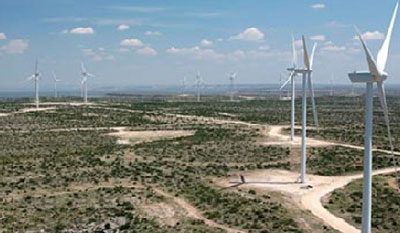For years, some critics of renewable energy have contended that it’s really no better than fossil fuels when you consider the entire lifecycle that goes into making their components.
They even say there may not be enough copper, steel and other resources to build all the solar panels and wind turbines needed for a low-carbon future. But comprehensive research recently released shows how far off their thinking is from reality.
It takes an enormous amount of energy to both build and then fuel fossil fuel power plants over their 40+ year lifetime, and during all those years they pump out pollution that seriously harms the health of people and the environment. How do wind turbines and solar panels compare?
Alta Wind Energy Center in Tehachapi, California:

Wind Turbines
& Solar PV
Researchers at Oregon State University looked at two typical 2-megawatt wind turbines and found they have a 6 month payback.
That means, for the first 6 months a turbine operates, it produces the same amount of energy that was required to build and install it in the first place.
Most of the greenhouse gas footprint of wind power comes from the extraction of raw materials needed to make them, such as copper, steel and fiberglass, and the energy consumed to turn those resources into turbines. They also factored in ongoing maintenance over 20 years as well as recycling and disposal costs at the end of life.
"Even in a worst-case scenario, lifetime energy requirements for each turbine will be subsumed by the first year of active use. Thus, for the 19 subsequent years, each turbine will, in effect, power over 500 households without consuming electricity generated using conventional energy sources," explain authors Karl Haapala and Preedanood Prempreeda in International Journal of Environmental Manufacturing.
These results "validate a large number of peer-reviewed studies, all of which show that wind energy quickly becomes a net
energy and emissions saver, typically within a few months of operations," says Michael Goggin, Director of Research for the American Wind Energy Association (AWEA).
The same is true for solar PV, where the payback period is between 0.5 and 1.4 years, depending on the kind of technology and the amount of sunlight available, according to the European Photovoltaic Industry Association.
Large-scale Wind and Solar
Deployment
It’s one thing to look at a single turbine or solar panel, but what about the cumulative effect of the world transition to renewable energy?
If renewable energy provides 39% of energy by 2050, would that end up creating more pollution than it eliminates through fossil-free electricity?
That’s what researchers asked in the first-ever lifecycle analysis of this transition. They conclude that just two years of current global copper production and one year of iron production would "build a low-carbon energy system capable of supplying the world’s electricity needs in 2050."
And during that time, carbon emissions would dive 62%, freshwater pollution would be cut in half and airborne particulates would decline by 40% – compared to sticking with fossil fuels instead.
Even though wind turbines use 14 times the iron and solar plants use 40 times the copper as fossil fuel plants (including natural gas), the impact pales in comparison to the raw materials needed for fossil energy. Why?
To keep coal plants going more coal must always be mined, but raw material extraction is a one-time event for renewable energy production.
"I was surprised that all pollution went down for renewables," Edgar Hertwich, lead researcher at Norwegian University of Science and Technology, told Climate Central. "I expected some toxics might rise
because of the materials used. Metal ores contain a lot of heavy metals. I
expected that to be significant. I was really surprised it didn’t show up. The amount of material
having to move for coal is more than metal moved for renewables."
And this doesn’t include the potential for recycling. When renewable energy plants need to be rebuilt, raw materials can be simply be recycled.
Read our article Solar Crosses Threshold to Net-Positive Energy
Production.
Here’s the study:

 Loading...
Loading...
Thanks for this important information.
Since some people complain about the use of copper for windmills, just for fun, I ran the numbers on the amount of copper used in pennies. You know, those coins virtually nobody wants. According to the U.S. mint, we are minting 6.848 billion cents in 2014. A U.S. cent weighs 2.5 grams and is 2.5% copper. The remainder is zinc. Multipying 2.5 times 6.848 billion gives us 17.12 billion grams or 17.12 million kg. Multiply that time .025 equals 428,000 kg of copper. This is for only one year of minting the cent coin. How many windmills can be built using this much copper? The only reason we still make this silly coin is because the state of Illinois doesn’t want it’s Lincoln head cent to go away. Lincoln was from IL, so they seem to derive some false importance from having the cent out there.
If we are serious about renewable energy, we’ll stop wasting resources on unnessesary items like the penny. We’ll instead use this metal for important things like wind energy.